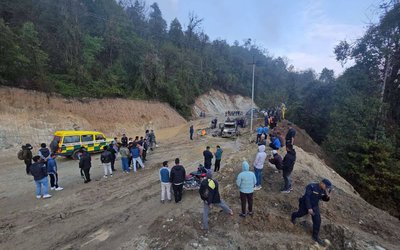It may sound a little paradoxical but the reality is that Nepal’s economy has registered unprecedented growth in both exports of goods as well as trade deficit in the recently concluded fiscal year. For the first time in history of Nepal our exports in the fiscal year 2078\79 approximated Rs. 200 billion, registering an increase of 41.74 percent over the total export (Rs.141 billion) of the previous fiscal year. Expectedly, our export to India was the highest, totaling. 155 billion. Soyabean, palm and sunflower oils fall under the major export items category. Likewise, yarn, garments, tea, coffee, cardamom, jute goods, steel and iron items also occupy an important position in the export basket. These items jointly account for about Rs. 184 billion of the total export earnings of Rs. 244 billion in the last fiscal year. Despite this remarkable growth in exports, however, the trade deficit is on the rise, which exceeded the downward adjusted total budgetary outlay of Rs. 1546 billion in just 11 months. It may be noted that Nepal Government in its half-yearly review had slashed the initial budgetary outlay of Rs. 1632 billion by Rs. 31 billion. The total trade deficit by the end of the fiscal year exceeded this figure, too. The trade deficit in the fiscal year 2077\78 had reached Rs. 1389 billion, which was more than the actual budget expenditure of Rs. 1180 billion that year. Exports remained encouraging early on last fiscal year, which is also shown by cent percent increase in export of goods in the very fifth month of the year. Despite this enhancement in the export of goods, however, the trade deficit has continued to rise. This paradox can be easily unknotted if we delve a bit into the composition of our international trade and import and export base. With a very weak base year (2077\78), improvement in the export of goods in 2078\79 looked relatively very impressive, while on the import front it was not so because it has remained very strong for years now, which is shown by its share in our total international trade and skyrocketing trade imbalance. We have not been able to check the speed at which import is increasing, despite different governments’ declaration to curb it.A look at the commodity composition of our trade may also help clarify the situation. Vegetable ghee and oil jointly explain about 50 percent of Nepal’s export. Soya bean oil, palm oil and sunflower oil, account for 25.06, 20.41 and 2.4 percent, respectively, of Nepal’s total export. Another painful reality is that this agricultural country imports these items in raw form and exports them without much value addition. Small wonder these oils appear as major items on both fronts- export and import. Increased export of these is somewhat nullified by the increased import of them in crude form. Another serious matter to be noted is that any decrease in import tariff on these items in India is certain to curtail the export of vegetable oil to India. There are reports that the removal of import duty on these items and fixation of goods and services tax (GST) at 5 percent by India has led to a sharp decline in our export of these items. It is reported that soya bean oil export stood at more than 180 million liters till the tenth month of the last fiscal year, which dropped to about 4 million liters in the eleventh month. A significant drop was noticed in the case of palm and sunflower oil also. It is disappointing that these items with little value addition and whose export is influenced by tariff adjustment in India appear as the number one item on our export list. If the contribution of these items in enhancing our import and the amount of hard currency that is expended on their purchase is looked into seriously at a time when the foreign exchange reserve is depleting, one could even go to the extent of branding sales of these oils as harmful exports. The concerned may wish to give some thought to this bitter reality, noting that our imports explained about 40 percent of the annual GDP last fiscal year. Cash incentives provided on export could play a significant role in arresting the ballooning trade imbalance if the value addition aspect is made a major factor to determine the level of cash incentive on export. Insignificant it could be monetarily at present, but the encouraging fact is that this country full of snow-fed rivers and pristine lakes has, at last, started exporting drinking water. Paradoxically, however, drinking water hardly flows from taps in the Valley, let alone the rest of the country. Likewise, increasing the export of tea and coffee (Rs.9.38 billion last fiscal year) and cardamom (Rs.4.81 billion) could help correct Nepal’s trade imbalance over time, also giving the country the much-needed foreign exchange.It is equally gratifying to note that Nepal has started exporting hydropower to India, which is likely to be a major source of export earnings along with cement.Nepal, facing serious problems on the external front, has to be choosy in selecting items\commodities for production and export. Taking into account the government’s declared policy of decreasing reliance on imported gas for heating and cooking purposes, the use of internally generated power will have to be encouraged. Power generation will have to be carried out on a war footing scale and its judicious allocation will have to be done to meet internal as well as export demand. Indeed, pragmatic actions are needed to help the ailing economy of Nepal.
Balance of payment (BOP) and current account remained negative during the last two years (2077\78 and 2078\79), under Oli and Deuba, respectively. Dr. Yubraj, Oli’s finance minister, however, may argue that the deficit on the two fronts increased substantially after Janardan Sharma(Deuba’s confidant now) became finance minister in the five-party coalition government. Sharma can also counter by citing higher economic growth (5.84 percent) during his period as against what was achieved (4.25 percent) earlier. The reinstated minister (Sharma) seems to be enjoying the full support of his party boss (Prachanda) and government head Deuba. It may be noted that Sharma had resigned after being accused of allowing unauthorized persons into the finance ministry on the eve of the budget presentation. A parliamentary panel probe, however, found no evidence to prove he was involved in making illegal changes to the budget. Making changes in budgets by finance ministers to accommodate their own interests as well as those of power centres is nothing new in Nepal. Sharma was unlucky that whatever little he did on the night of May 28 leaked and lots of noise was created in the Parliament and on the streets of Kathmandu, leaving Sharma with no option but to resign. Sharma can also console himself by remembering that Yubrarj was also accused of making surprising tariff changes in favour of a prominent business group and some opposition leaders had demanded his resignation in the Parliament but he continued to stay on, turning a deaf ear to their murmurs. What Oli wanted was more important for him than noises in the House by opposition leaders. It is difficult to believe that the minister in charge can make major budgetary alterations independent of the wishes of powerful people who we have seen over time not only defending controversial actions of their finance ministers but privately patting their back for accommodating their interests. The patting received this time, however, will be of no help in budget execution as major attention of political leaders including Sharma will be diverted towards federal and provincial polls to be held on November 20. The current budget, Sharma may note, has stated that every citizen will have access to electricity within 2 years, gas cylinders will be displaced and total imports will be reduced by 20 percent each year so that trade could be balanced in 5 years. It has also mentioned that the import of agricultural products such as maize will be reduced by at least 30 percent, which unfortunately has coincided with a 5 percent drop in rice area, compared with the area under rice last season. It is reported that rice transplantation in the major rice-growing area (Madhes Pradesh) has gone down by 25 percent. It may be difficult to curtail the import of agricultural products as stated in the budget. Nepal imports rice and paddy worth Rs. 50 billion annually. It is apprehended that food insecurity could increase in a country like Nepal because import from India may not be as easy as before, in the face of the country’s recent restriction on the export of certain items, and the shaken global grain market on account of a war between Russia and Ukraine. Some solace, however, is drawn from the Turkey\UN -brokered grain deal signed in Istanbul on July 22, which allows the export of Ukrainian grains through ports in the Black Sea. The deal is likely to ease food inflation and save millions of people from starvation. Another encouraging factor for Nepal is that Nepal Rastra Bank in its monetary policy for this fiscal year has encouraged lending to productive areas even in the present difficult time when inflation is on the rise in Nepal and elsewhere and monetary authorities all over the world are continuously increasing interest rates. Indeed, it would be unfair to blame our central bank for tightening the flow of credit to unproductive areas and initiating measures to hike rates and mop up liquidity from the market. Foodgrains, fish and livestock production, export-oriented undertakings and industries using local raw materials, handicrafts, etc are likely to benefit. Moreover, unlike unsatisfactory execution of budgets in Nepal, implementation of monetary policy has mostly remained up to the expectation of the concerned. However, efforts of the central bank could be stymied by never-ending unhealthy activities of politicians currently focused on forging alliances, by hook or crook, to jointly contest and win elections and thereafter do whatever is needed to remain in power. The present situation in Nepal reminds one of the politicians in some African countries who have been, since long, leaving no stone unturned to grab political power, which has become the most effective tool to loot these mineral-rich countries with rampant corruption and abject poverty. It may not be too difficult to draw parallels between what is happening there and here.

Dr. Tilak Rawal
Dr. Rawal is former governor of NRB.
- Six Months Of Deuba And Oli
- Jan 25, 2025
- Prachanda Outsmarted
- Jul 19, 2024
- Prachanda Outsmarts Again
- Apr 14, 2024
- Prachanda Completes One Year
- Jan 26, 2024
- Terrible Times To Continue
- Oct 12, 2023














